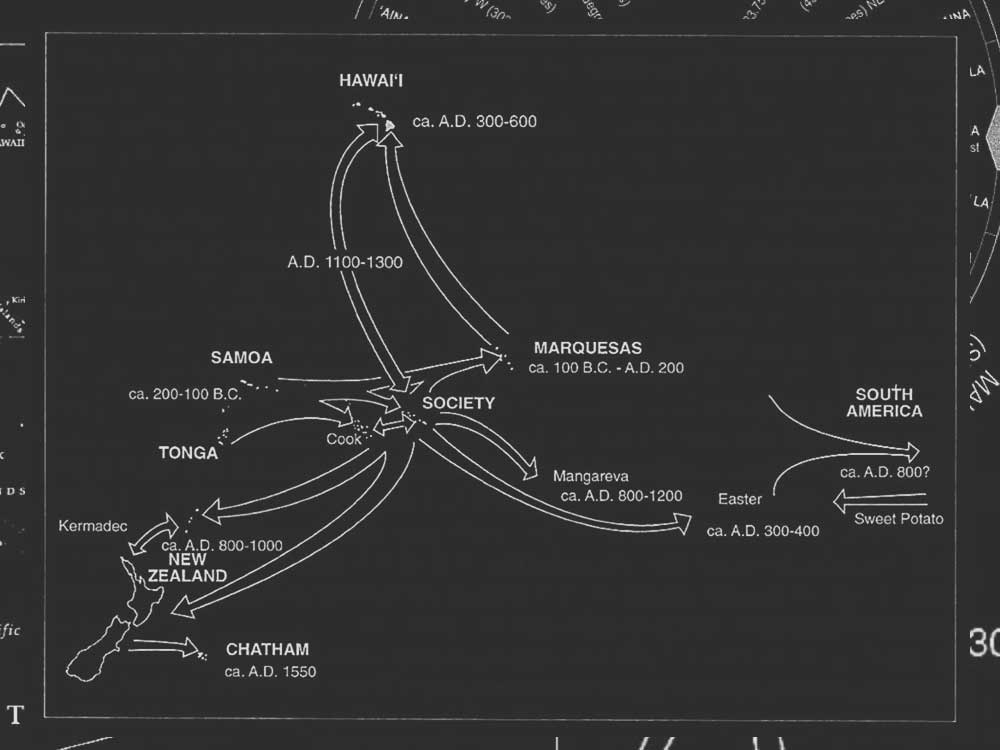Navigators

In the introduction to his book, Myths and Legends of Hawaiʻi, King Kalākaua wrote a brief history that included the settlement of Hawaiʻi. According to his text, Nanaula, a distinguished chief was the first to arrive in the islands from “southern islands” around 400-600 A.D. During this chief’s lifetime, other settlers arrived, and none of them ever returned to their former homes. For thirteen or fourteen generations these first occupants remained isolated with their own traditions. In late 900 A.D. or early 1000 A.D. another group arrived, “probably from the Society group,” under the leadership of the war-like chief Nanamaoa. Other aggressive leaders soon followed, including a chief named Paʻao and another named Pili who were said to arrive during the time of Nanamaoa’s grandson. Pili became the chief over the island of Hawaiʻi and Paʻao became his priest, establishing new religious rites and introducing new gods. Cross voyaging between Hawaiʻi and southern Polynesia continued after the arrival of these chiefs for about 150 years. Sometime in very late 1100, according to King Kalākaua, this cross voyaging inexplicably ceased.
Evidence from the disciplines of archaeology, linguistics, physical anthropology, and ethnobotany point to the Marquesas Islands as the immediate homeland of Hawai’i’s first settlers. However, it is said this does not preclude the possibility of more than one settlement voyage from the Marquesas, the Society Islands or some other East Polynesian group (Kirch 66). Another Pacific historian points out that there is an “initial uniformity to Marquesan society and Society Island cultures” (Howe 39). Archaeologists vary on their estimations of the first settlement dates of the Hawaiian Islands, and differing dates range from approximately 300 AD to 1,000 AD. In considering the history of Kūkaʻōʻō Heiau and Mānoa Valley, archaeologist Patrick Kirch’s delineation of four historic periods is useful:
- Colonization takes place between 300 A.D. and 1,000 A.D. (these dates always change),probably from the Marquesas or Society Islands. There was probably an initial settlement of about 100 people. These settlers brought crop plants and had fishing skills and made their first homes on the windward side of the island. Not much is known about initial settlement and so far, only two archaeological sites reflect this period.
- The Developmental Period from 900 A.D. to 1100 A.D. is characterized by increased population. There is a spreading of initial settlements into leeward areas and distinctively Hawaiian cultural patterning begins.
- During the Expansion Period from 1100 A.D. to 1650 A.D. classic Hawaiian culture emerges. Agriculture expands due to new irrigation techniques. Fishponds for aqua culture appear. Toward the end of this era come the rise of paramount chiefs and the stratification of society. Between 1100 A.D. and 1200 A.D. Paʻao arrives and introduces human sacrifice in connection with the worship of the god Kū. At the end of this era religious ideology supports power and position with elaborate heiau and rituals. (It is also interesting to note that Hawaiian historian Samuel Kamakau cites the chief Maʻilikūlkahi with creating the “ahupuaʻa” system of land division in about 1500. This system, once established, would certainly enhance political control of the paramount Chiefs).
- During the Proto-Historic Period from 1650 A.D. to 1795 A.D., Hawaiian society developed a societal structure with a hierarchy of chiefs, priests, occupational specialists, commoners, kapu that was more elaborate than any other Polynesian society. Because this is the era closest to Western contact (1778), a great deal is known about this time period. Hawaiians conducted many rituals to their gods at sites called heiau. Something we could reflect on concerning the settlement of the islands and the development of a Hawaiian culture is the manner in which an elaborate material culture was developed over time. Polynesian settlers brought few tools and plants with them. Yet, they developed a material culture that fed, clothed and housed a large population. For the most part, it was a culture without imports. The people used what they found in their environment, and at the same time saw the inherent value in preserving and maintaining a healthy environment. They were extremely conscious and respectful of the natural world.
For more information on voyaging, please visit The Polynesian Voyaging Society at https://www.hokulea.com/.